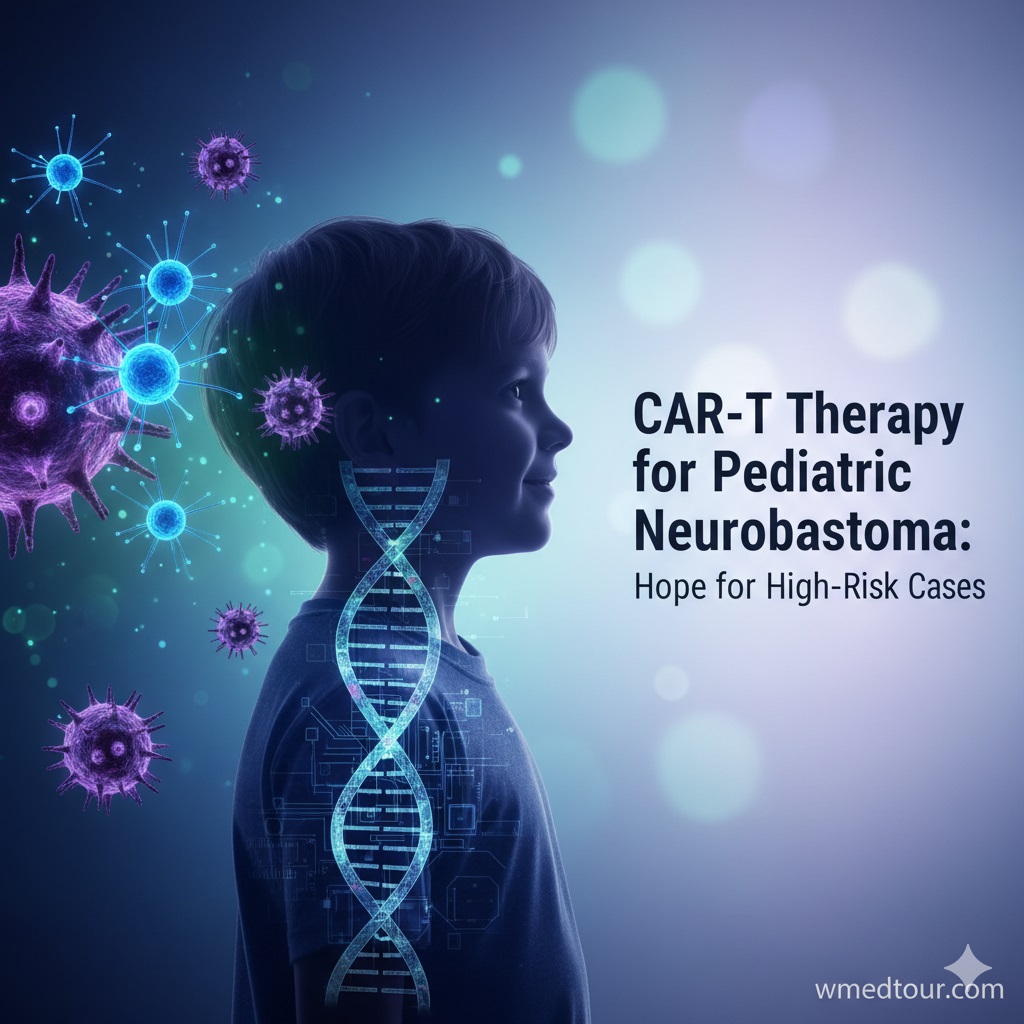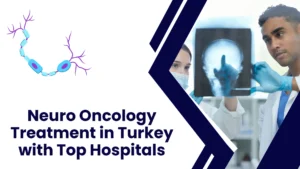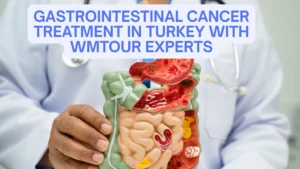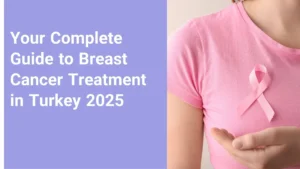CAR-T Therapy for Pediatric Neuroblastoma: Hope on the Horizon for High-Risk Cases
Executive Summary: Key Takeaways
- Precision Target: The primary target for CAR-T in neuroblastoma is the GD2 antigen, which is highly expressed on tumor cells and minimally present in healthy tissue.
- The Challenge: High-risk and especially Relapsed or Refractory Neuroblastoma (R/R NB) carry a poor prognosis, where traditional treatments often fail to secure a durable, long-term cure.
- The Promise: GD2-CAR-T represents a revolutionary approach, being the first cellular immunotherapy designed specifically for pediatric solid tumors. This therapy aims to achieve deep remission and eliminate minimal residual disease (MRD).
- Breakthrough Potential: CAR-T is projected to significantly increase complete remission rates and offers a potent, later-line treatment that can complement or even surpass current monoclonal antibody therapies.
Neuroblastoma is a challenging pediatric cancer, responsible for a disproportionate number of childhood cancer-related deaths. However, advances in cellular immunotherapy are opening new doors. Specifically, CAR-T Therapy for Pediatric Neuroblastoma is emerging as a groundbreaking, potentially curative option for those facing the toughest prognoses. This comprehensive guide will explore the science, the patient journey, and the clinical advantages of this cutting-edge treatment.
Before proceeding, for more detailed information on foundational oncology principles, you can explore advanced immunotherapy techniques.
Table of Contents
- Understanding Pediatric Neuroblastoma: The High-Risk Challenge
- CAR-T Therapy for Pediatric Neuroblastoma: A Precision Immune Weapon
- GD2-CAR-T vs. Traditional Treatments: A Comparative Analysis
- The CAR-T Patient Journey: Step-by-Step
- Who is This For? Determining Eligibility for CAR-T Therapy
- Real-World Promise: A Hypothetical Case Study
- GHG’s Leadership in CAR-T Therapy for Pediatric Neuroblastoma
- Frequently Asked Questions (FAQ)
1. Understanding Pediatric Neuroblastoma: The High-Risk Challenge
Neuroblastoma originates from neural crest cells and stands as the most common solid tumor outside the brain in young children. In fact, it accounts for a staggering 50% of all tumors diagnosed in infants under one year old. Despite these statistics, its deadliness is clear: it contributes to roughly 15% of all childhood cancer-related fatalities.
The Difficulty of Relapsed/Refractory Neuroblastoma (R/R NB)
While low-risk neuroblastoma often results in high cure rates, the outlook for high-risk neuroblastoma is much grimme, with five-year survival hovering around 50–60%. Consequently, it presents one of the most formidable challenges in pediatric oncology. Specifically, the real struggle centers on Relapsed or Refractory Neuroblastoma (R/R NB). Even after undergoing intensive, multimodal therapy, the disease frequently recurs and metastasizes, often to hidden sites like the bone marrow and bone. Navigating these R/R NB challenges demands innovation. Traditional options have historically failed to provide durable remissions, meaning a genuine, long-term cure remains exceedingly rare.
Research into the mechanisms of relapse is ongoing at leading institutions. For instance, studies into pediatric solid tumor immunotherapy at the Memorial Sloan Kettering Cancer Center show the necessity of new modalities like CAR-T to achieve deeper, more persistent responses.
2. CAR-T Therapy for Pediatric Neuroblastoma: A Precision Immune Weapon
The imperative for more effective, targeted treatments for high-risk and R/R NB is critical. This is where CAR-T Therapy for Pediatric Neuroblastoma steps in. Chimeric Antigen Receptor (CAR) T-cell therapy offers a revolutionary paradigm shift by effectively reprogramming the body’s own T-cells to become precision killers .
Why GD2 is the Ideal Target
First and foremost, the key to immunotherapy in neuroblastoma lies with the GD2 antigen. This disialoganglioside molecule is expressed in high abundance on the surface of neuroblastoma tumor cells. Furthermore, its expression is remarkably restricted in normal, non-cancerous tissues, making it an *ideal* tumor-specific target for minimizing off-target toxicity. Learning about the GD2 antigen target is the first step in understanding this therapy.
Mechanism: How GD2-CAR-T Cells Work
GD2-CAR-T is not just another drug; it is a personalized, living therapy. The process is systematic and highly controlled:
- Collection (Apheresis): The clinical team **collects** T lymphocytes from the patient’s blood, similar to a blood donation.
- Engineering: A specialized laboratory **genetically modifies** these T-cells. The modification involves introducing a gene that makes the cells express a Chimeric Antigen Receptor (CAR), which is engineered to specifically recognize the GD2 antigen. Research on T-cell engineering at Harvard Medical School highlights the complexity of this step.
- Expansion: The new GD2-CAR-T cells are multiplied into the millions, creating an army of cancer-fighting cells.
- Infusion & Targeting: The team **infuses** the engineered CAR-T cells back into the patient. Consequently, these cells precisely identify, track, and destroy GD2-positive tumor cells, offering the unique capability to eliminate minimal residual disease (MRD) and establish immune surveillance.
3. GD2-CAR-T vs. Traditional Treatments: A Comparative Analysis
For years, anti-GD2 monoclonal antibodies have been the backbone of post-induction therapy for neuroblastoma, certainly improving survival rates. However, their efficacy is often limited in patients presenting with high tumor burden or R/R disease, and they rarely achieve the depth of remission required for a long-term cure. In contrast, CAR-T Therapy for Pediatric Neuroblastoma represents a quantum leap in this therapeutic space. To understand the difference, here is a comparison.
Pros and Cons: CAR-T vs. Monoclonal Antibodies
GD2-CAR-T Therapy
Pros:
- High Potency: A living drug that expands *in vivo* and maintains activity, leading to superior tumor cell killing.
- MRD Elimination: Proven potential to eradicate microscopic disease, which is vital for long-term survival. Dana-Farber research on MRD underscores its importance.
- Single Infusion: Can provide durable remission after a one-time treatment.
- Ability to Track: Cells can track and eliminate lesions in challenging, hidden sites like the bone marrow.
Cons:
- Toxicity Profile: Risk of specific immune-related toxicities (CRS, ICANS).
- Manufacturing Time: Requires time for cell collection and genetic engineering.
- Specialized Centers: Must be administered at highly specialized centers.
Anti-GD2 Monoclonal Antibodies
Pros:
- Accessibility: More broadly available in oncology centers.
- Established Use: Long-standing record as a standard of care post-transplant.
- Toxicity: Predictable, primarily infusion-related pain, which is manageable.
Cons:
- Limited Efficacy: Less effective against bulky disease or high tumor burden.
- Frequency: Requires multiple cycles of treatment over several months.
- Lack of Durability: Does not establish long-term immune memory against the cancer.
Treatment Comparison Table
| Feature | GD2-CAR-T Therapy | Monoclonal Antibodies | Standard Chemotherapy |
|---|---|---|---|
| Mechanism | Living T-cells target GD2, creating immune memory. | Protein attaches to GD2, flagging cancer for destruction. | Toxic drugs kill rapidly dividing cells (cancer and healthy). |
| Aim of Treatment | Eliminate MRD and achieve deep, durable remission. | Maintain remission; immediate cell killing. | Rapidly shrink bulk tumor. |
| Delivery | Single infusion (potentially). | Multiple cycles (months). | Multiple cycles (weeks/months). |
4. The CAR-T Patient Journey: Step-by-Step
The journey with CAR-T Therapy for Pediatric Neuroblastoma is complex and requires specialized expertise. Therefore, multidisciplinary collaboration is essential at every stage, from initial consultation to long-term follow-up. This process is highly standardized to maximize safety and efficacy. The University of Pennsylvania’s CAR-T research protocols exemplify this detailed approach.
- Step 1: Pre-treatment Evaluation. The clinical team **conducts** a comprehensive assessment to confirm the patient’s eligibility and readiness. This includes detailed imaging, disease staging, and organ function tests. Read about pre-conditioning chemotherapy protocols.
- Step 2: Cell Collection & Preparation. T-cells are harvested via apheresis. The T-cells are then shipped to a manufacturing facility for genetic engineering and expansion—a process that can take several weeks.
- Step 3: Pre-Infusion Preparation. While manufacturers **prepare** the cells, the patient often undergoes lymphodepleting (preconditioning) chemotherapy. Doctors **use** this treatment to clear out existing T-cells, creating space for the new, powerful CAR-T cells to thrive upon infusion.
- Step 4: CAR-T Infusion & Management. The medical team **infuses** the GD2-CAR-T cells back into the patient, typically over a short period. Subsequently, the clinical team **monitors** the patient intensively in the hospital for potential adverse events, such as Cytokine Release Syndrome (CRS) and Immune Effector Cell-Associated Neurotoxicity Syndrome (ICANS).
- Step 5: Ongoing Care & Follow-up. After discharge, patients begin an intensive schedule of regular check-ups, imaging, and long-term surveillance. This phase focuses on monitoring for disease recurrence and assessing the long-term persistence of the CAR-T cells. Post-transplant care research from Children’s Hospital of Philadelphia guides this long-term management.
Navigating Potential Side Effects
Indeed, as a powerful therapy, CAR-T comes with specific potential side effects, primarily CRS and ICANS. However, specialized centers have highly effective protocols, including the use of drugs like Tocilizumab, to manage these toxicities quickly and safely, which is a key consideration when managing Cytokine Release Syndrome.
5. Who is This For? Determining Eligibility for CAR-T Therapy
Generally speaking, specialists **generally reserve** CAR-T Therapy for Pediatric Neuroblastoma for children who fall into the following categories:
- Relapsed or Refractory Neuroblastoma (R/R NB): Patients whose disease has returned after initial treatment or has failed to respond to standard induction therapy.
- High-Risk Neuroblastoma: Those with aggressive disease characteristics that predict a poor outcome with conventional approaches alone.
- Minimal Residual Disease (MRD) Management: Patients in deep, but not complete, remission where the goal is to eliminate any lingering microscopic disease before it can cause a full relapse. Learn more about MRD.
- Eligibility Criteria: Patients must meet specific clinical criteria, including adequate heart, lung, kidney, and liver function, to safely tolerate the treatment and the associated conditioning chemotherapy. UCSF’s work on clinical trials for R/R NB provides examples of strict eligibility.
6. Real-World Promise: A Hypothetical Case Study
To illustrate the impact of CAR-T Therapy for Pediatric Neuroblastoma, consider ‘Patient Leo,’ a hypothetical 6-year-old:
Leo was initially diagnosed with high-risk neuroblastoma. He completed standard multimodal therapy, including surgery, chemotherapy, and a stem cell transplant. Despite this extensive treatment, six months later, surveillance imaging revealed a relapse in the bone and bone marrow, classifying his disease as R/R NB. Conventional chemotherapy failed to clear the disease completely, leaving behind persistent tumor cells (MRD). His team determined that his best chance for a durable cure was a cellular approach.
Therefore, Leo was enrolled for GD2-CAR-T therapy. After collection and manufacturing, he received the CAR-T infusion. As expected, within two weeks, his doctors observed signs of CAR-T cell activation, which they carefully managed. Following the infusion, subsequent scans showed no evidence of disease, and his bone marrow biopsies were negative for neuroblastoma cells. The CAR-T cells successfully located and eliminated the persistent MRD. Leo continues to be monitored closely, but the use of CAR-T Therapy for Pediatric Neuroblastoma granted him a deep remission that was previously unattainable with standard re-induction chemotherapy.
7. GHG’s Leadership in CAR-T Therapy for Pediatric Neuroblastoma
The GOBroad Healthcare Group (GHG) has established itself as a national leader in cellular therapy, built on years of extensive experience and dedication to pediatric oncology research. Our expert team has completed nearly 5,000 CAR-T treatments across more than 50 clinical trials since 2015, achieving outcomes recognized globally for their safety and long-term survival rates in complex cases. Review our clinical trial results for more details.
Pioneering Research and Clinical Trials
GHG holds systematic advantages in translational and clinical research for high-risk NB. Specifically, our team led world-first studies, including the use of umbilical cord blood NK cells for R/R NB and advanced GD2-CAR-T trials utilizing the innovative multi-target Bicephail platform. Our work also involves exploring novel combinations, such as anti-GD2 monoclonal antibodies combined with PD-1 antibodies, which has been shown to significantly improve progression-free survival (PFS) in relapsed patients.
Furthermore, our commitment extends to fundamental science. Published studies promote crucial risk stratification and efficacy prediction strategies for the NB immune microenvironment, including research into neuroblastoma genetics at St. Jude Children’s Research Hospital.
Multidisciplinary Care: Safety and Quality of Life
We believe advanced therapy requires comprehensive support. GHG utilizes a robust multidisciplinary team (MDT) approach, integrating specialists from imaging, surgery, radiotherapy, pathology, nuclear medicine, and oncology. This team supports every step, ensuring integrated management from pre-treatment evaluation to long-term follow-up. Ultimately, we balance safety and efficacy, providing patients with advanced therapies while prioritizing a higher quality of life throughout the process. Understand the importance of MDT collaboration.
8. Frequently Asked Questions (FAQ) about CAR-T Therapy for Pediatric Neuroblastoma
Q1: Is CAR-T a cure for Neuroblastoma?
A: CAR-T therapy is a highly potent treatment that can lead to deep and durable complete remission, especially in R/R NB. While it offers a strong potential for long-term cure, you **must discuss** the specific prognosis and success rates with your oncologist, as results vary based on the patient’s disease history.
Q2: How long do the CAR-T cells stay in the body?
A: The persistence of the engineered CAR-T cells is a key indicator of long-term success. Studies show that these cells can persist for months to years, providing ongoing immune surveillance against GD2-positive cells. This long-term persistence is a major advantage of CAR-T Therapy for Pediatric Neuroblastoma.
Q3: What does ‘Relapsed or Refractory’ mean?
A: ‘Relapsed’ means the cancer returned after a period of remission. ‘Refractory’ means the cancer did not respond to initial standard treatment. These terms define the patient population that is in the highest need of innovative treatments like CAR-T.
Q4: Is the GD2 antigen found on any normal cells?
A: GD2 is highly expressed on neuroblastoma cells, but it is also found at low levels on some normal cells, primarily in the peripheral nervous system. Consequently, this low-level expression is the reason CAR-T therapy can sometimes cause temporary neurotoxicity, which is closely managed by the medical team. Stanford research on GD2 signaling discusses this.
Q5: What is the age range for this therapy?
A: While neuroblastoma is primarily a disease of young children, eligibility for CAR-T is based on the disease state and overall health, not strictly age. GD2-CAR-T is the first cellular therapy developed for pediatric solid tumors, so it is tailored for this age group, from toddlers to adolescents.
Q6: How long is the entire treatment process?
A: The duration varies. The cell collection is quick, but the manufacturing period typically takes several weeks. The in-hospital stay for the infusion and initial monitoring usually lasts 2-4 weeks. Therefore, the total treatment window from collection to initial recovery is often 6-10 weeks.
Q7: Does CAR-T replace a stem cell transplant?
A: Not necessarily. In high-risk treatment protocols, CAR-T is often used as a potent “later-line” therapy, either after a transplant or in patients who relapse post-transplant. It may also be investigated as a strategy to eliminate MRD before or after a transplant in sequential strategies. Explore sequential transplant strategies.
Q8: What is the significance of the “Bicephail platform”?
A: The Bicephail platform is an innovative multi-target approach used to engineer the CAR-T cells. This is a type of CAR structure designed to potentially increase the effectiveness and specificity of the cells, improving outcomes for CAR-T Therapy for Pediatric Neuroblastoma patients.
Q9: What happens if the cancer cells lose the GD2 target?
A: Tumor escape mechanisms, such as the loss of the target antigen (GD2), are a challenge. Consequently, researchers are developing next-generation CAR-T cells that target *multiple* antigens (bi- or tri-specific CARs) to anticipate and overcome this potential resistance mechanism.
Q10: Are there any late-term side effects to monitor?
A: Long-term surveillance focuses on monitoring for B-cell aplasia (if the CAR targets a B-cell marker, though less common in GD2-CAR-T) and potential secondary malignancies or late effects of the entire intensive treatment regimen. The clinical team **monitors** patients indefinitely. Seattle Children’s research on CAR-T toxicity provides insight.
Q11: Can CAR-T be combined with PD-1 antibody treatment?
A: Yes, research shows promise in combining anti-GD2 therapies with immune checkpoint inhibitors like PD-1 antibodies, especially for relapsed patients, to try and boost the immune response and prevent tumor evasion. This is part of advanced immunotherapy.
Q12: Why is the multidisciplinary team (MDT) approach so important for CAR-T?
A: CAR-T therapy involves oncology, pathology, nuclear medicine, and critical care. Therefore, a dedicated MDT ensures seamless, integrated management, allowing for immediate intervention for complex side effects and the optimal timing of treatment steps, directly improving patient safety and outcomes.
Disclaimer: This information is for educational purposes only and does not constitute medical advice. Consult with a qualified healthcare professional for personalized medical guidance.




